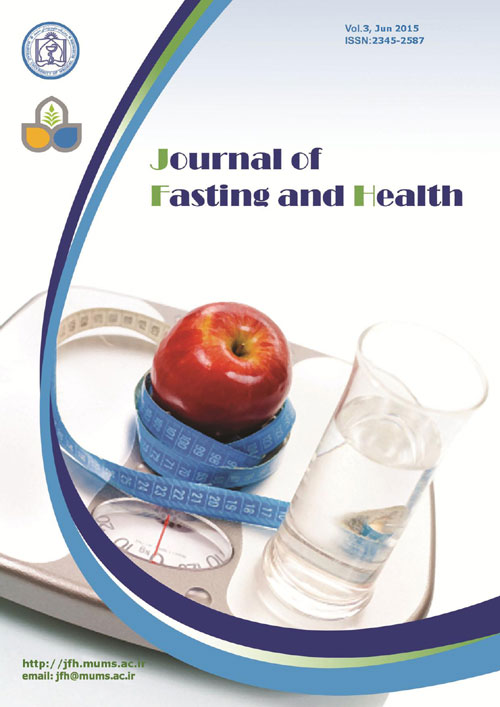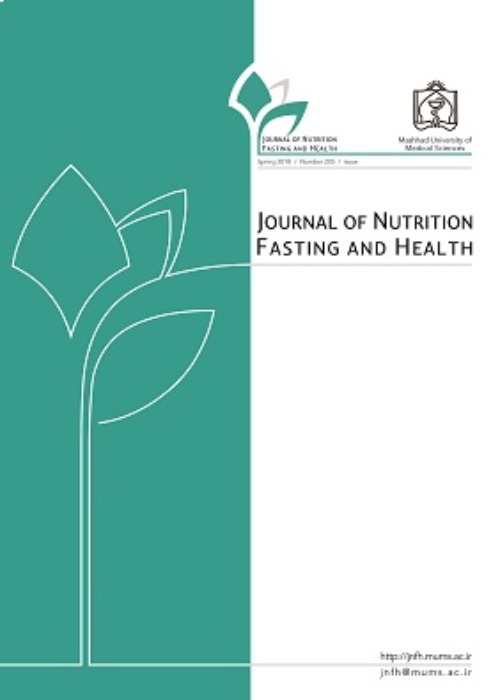فهرست مطالب

Journal of Nutrition, Fasting and Health
Volume:3 Issue: 1, Winter 2015
- تاریخ انتشار: 1394/01/31
- تعداد عناوین: 8
-
-
Pages 4-10Over a billion of Muslims fast worldwide during Ramadan each year. Through this religious custom, fasting contributes to their health as well as their spiritual growth. However, available evidence regarding the health-benefits of Ramadan fasting is scarce and highly contentious. Although Islam exempts patients from fasting, many fast conceivably, and their clinical condition is prone to deteriorate due to persistent gap between current expert knowledge and conclusive strong evidence regarding the pathophysiologic and metabolic alterations of fasting and the consensus that should be taken into account to implements guided managing of various patient groups during Ramadan fasting among health care professionals. In this article, we summarized the results of initial studies regarding the effects of Ramadan fasting on some clinical conditions including alterations of body composition and clinically important outcomes of patients with a previous history of cardiovascular disease, asthma and renal colic disease. Our studies have shed light on several outcomes in favor of Ramadan fasting, and encourage those with mentioned diseases to consult their physicians and follow medical and scientific recommendations. In this review we aimed to present a piece of relevant evidence, clarify future scope and provide suggestions for future investigations.
-
Pages 11-17PurposeThe present study aimed to review the effect of dehydration during Ramadan fasting on the health and ocular parameters leading to changes in eye function.MethodsArticles included in the study were taken from Pub Med, Ovid, Web of Science and Google Scholar up to 2014. Related articles were also obtained from scientific journals in fasting and eye.ResultsDehydration and nutrition changes in Ramadan cause an increase in tear osmolarity, ocular aberration, anterior chamber depth, IOL measurement, central corneal thickness, retinal and choroidal thickness. And also a decrease in IOP, tear secretion, and vitreous thickness.ConclusionBesides many research in relation to effect of dehydration impact on ocular parameters during Ramadan fasting, although the findings reveal it is associated with significant changes on ocular parameters. It seems requisite to have comprehensive study in «fasting and ocular parameters” which will be helpful in making decision and giving plan to the patients.Keywords: Ramadan fasting, dehydration, intraocular pressure, tear osmolarity, ocular biometry
-
Pages 18-20Autosomal dominant polycystic kidney disease (ADPKD) is the most common form of inherited kidney disease that results in renal failure. PKD currently has no causative therapy. However, some treatment options are available, ranging from symptomatic therapy to delaying the onset of end-stage renal failure. Early diagnosis of adult polycystic kidney disease is vital in order to prevent its complications. Ultrasonongraphy and genetic testing are the two preferred diagnostic techniques with defined limitations, mainly regarding age. Herein, we report a case of an ADPKD family whom visited the genetic counseling clinicFasting; polycystic kidney disease; 16-year-old girl for determining the disease risk in their symptom-free girls aged 16 and 22 years, and discussing other related issues such as their concern about fasting in Ramadan.Keywords: Fasting, polycystic kidney disease, 16, year, old girl
-
Pages 21-28During Ramadan fasting quantity and quality of dietary intake may change. There was no data on nutrient patterns in Ramadan fasting. The purpose of this study was to identify Ramadan major nutrient patterns among those who fast in Tehran, Iran. 510 fasting people aged 18-65 years and BMI 18.5-40 Kg/m2 were recruited in our study by 2-stage cluster sampling method in June-July 2014. Data on the socio-demographic and physical activity level were collected by questionnaire. Usual diet during Ramadan was estimated by valid and reliable food frequency questionnaire. BMI was calculated based on measured height and weight. Three nutrient patterns derived by conducting principal component factor analysis on 30 major nutrients. Micronutrient and fiber pattern which characterized by high intake of vitamin K, total fiber, iron, manganese, magnesium, β-carotene, folate, vitamin B12, potassium and calcium was adversely associated with weight (b=-0.16, P= 0.004). High protein pattern had great loadings on protein, riboflavin, phosphorous and zinc which physical activity level was decreased by tertiles of this pattern (b=0.13, P=0.02). High carbohydrate pattern which presented high positive loadings on carbohydrate and thiamin and negative loading on total fat, poly unsaturated fatty acids and monounsaturated fatty acids was positively associated with BMI (b= 0.12, P=0.03). Adherence to different Ramadan nutrient patterns is associated with weight, BMI and physical activity level. People on high in carbohydrate may have a higher BMI and low micronutrient density diet that should be considered in Ramadan fasting nutrition educational programs.Keywords: Ramadan fasting, nutrient pattern, factor analysis
-
Effects of Ramadan fasting on the sexual hormones level in girls 9-13 years age girls: Mashhad, IranPages 22-27AimThe present study was designed to evaluate the effects of Ramadan fasting on sex hormones in girls between 9-13years before age of menarche. Method and Materials: The study was carried out on a sample of 58 subjects (aged 9-13 years) into two groups (31 Fasting and 27 Non-fasting). FSH, LH, progesterone and estradiol were measured before and after Ramadan.ResultsFSH level increased significantly in non-fasting group (P=0.01). DHEA level had significant decrease during the time of study in both groups (p=0.001, p=0.006). Serum LH level in non-fasting group increased significantly after Ramadan (P=0.006). Moreover, estradiol level had significant increase in both groups (P=0.008, P=0.004).ConclusionAccording to the similar changes in DHEA, progesterone and estradiol levels in both groups, it can be concluded that fasting does not affect these parameters as well some other affecting factors were responsible for changes in LH and FSH levels.Keywords: Ramadan fasting, pre, menarche girls, sex hormones, puberty, Diet
-
Pages 29-34Background and ObjectivesFasting in the month of Ramadan has several positive effects on the emotional and mental state and improves happiness in the community. This study aimed to investigate the effects of fasting on the level of happiness in the general population.Materials And MethodsIn this study, we used pretest-posttest analysis to evaluate the hypothesis, and the study population consisted of the people of Kermanshah, Iran. In total, 110 individuals were selected randomly, and the evaluation of happiness was performed using MUNSH happiness survey including four scales of positive appreciation (PA), positive experience (PE), negative appreciation (NA) and negative experience (NE). Data analysis was performed using T-test in SPSS V.18.ResultsIn this study, a significant difference was observed between the level of happiness before and after the month of Ramadan. Moreover, there was a significant difference between the pre-test and post-test in terms of NA (P=0.032, T=2.16) and NE (P=0.001, T=3.302). However, no significant difference was observed in PA and PE before and after Ramadan in the study population.ConclusionAccording to the results of this study, fasting could positively affect the level of happiness in a community. Therefore, further attention needs to be drawn to the religious beliefs of people and their effects on the mental health of a society.Keywords: Fasting, Happiness, Positive appreciation, Positive experience, Negative appreciation, Negative experience
-
The Effects of Aerobic Exercise on the Levels of Leptin and Adiponectin in Overweight Women (ahead of publication)Pages 41-46Background and ObjectivesSeveral epidemiological studies have indicated factors such as Leptin level, Adiponectin and plasma adiponectin-to-leptin index to be the predicting biomarkers for cardiovascular diseases. Given the importance of healthy nutrition and adequate exercise in reducing the risk of Atherosclerosis, this study aimed to investigate the effects of fasting and aerobic exercise on the level of leptin and adiponectin in overweight women.Materials And MethodsIn this study, 27 overweight and obese women with the body mass index (BMI) of ≥25 kg/m2 and the age range of 45-20 years were selected by targeted sampling and were divided into two groups of fasting accompanied with aerobic exercise (N=15), and fasting only (N=12). The active group had an exercise protocol including three 60-minute sessions of aerobic exercise per week, with the maximum heart rate of 50-65%. Anthropometric dimensions and blood levels of leptin and adiponectin were measured in all the subjects before, at the second week and the fourth week and one week after Ramadan. Data analysis was carried out using repeated measures, and a P value of ≤0.05 was considered significant.ResultsIn this study, one month of fasting accompanied with aerobic exercise had a significant effect on the amount of leptin, adiponectin and leptin-to-adiponectin ratio (P<0.05). However, no significant differences were observed between the two study protocols in terms of changes in leptin, adiponectin and leptin-to-adiponectin ratio in the two study groups.ConclusionAccording to the results of this study, aerobic exercise during Ramadan could not result in any significant changes in the level of leptin, adiponectin and adiponectin-to-leptin index in comparison to fasting alone. The insignificant differences in the changes of leptin and adiponectin indices between the two study protocols could be due to the insufficient number of aerobic exercise sessions, as well as the low intensity and duration of the exercises.Keywords: Fasting, Aerobic exercise, Atherosclerosis, Leptin, Adiponectin, Women


